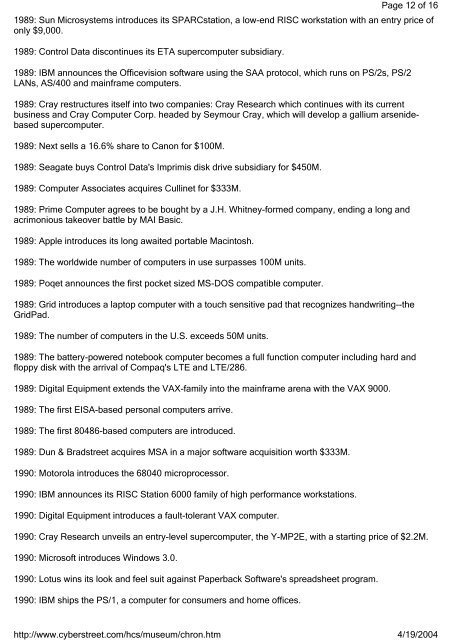A Chronology of Computer History: 3000 BC: Dust abacus is ...
A Chronology of Computer History: 3000 BC: Dust abacus is ...
A Chronology of Computer History: 3000 BC: Dust abacus is ...
You also want an ePaper? Increase the reach of your titles
YUMPU automatically turns print PDFs into web optimized ePapers that Google loves.
1989: Sun Microsystems introduces its SPARCstation, a low-end RISC workstation with an entry price <strong>of</strong><br />
only $9,000.<br />
1989: Control Data d<strong>is</strong>continues its ETA supercomputer subsidiary.<br />
1989: IBM announces the Officev<strong>is</strong>ion s<strong>of</strong>tware using the SAA protocol, which runs on PS/2s, PS/2<br />
LANs, AS/400 and mainframe computers.<br />
1989: Cray restructures itself into two companies: Cray Research which continues with its current<br />
business and Cray <strong>Computer</strong> Corp. headed by Seymour Cray, which will develop a gallium arsenidebased<br />
supercomputer.<br />
1989: Next sells a 16.6% share to Canon for $100M.<br />
1989: Seagate buys Control Data's Imprim<strong>is</strong> d<strong>is</strong>k drive subsidiary for $450M.<br />
1989: <strong>Computer</strong> Associates acquires Cullinet for $333M.<br />
1989: Prime <strong>Computer</strong> agrees to be bought by a J.H. Whitney-formed company, ending a long and<br />
acrimonious takeover battle by MAI Basic.<br />
1989: Apple introduces its long awaited portable Macintosh.<br />
1989: The worldwide number <strong>of</strong> computers in use surpasses 100M units.<br />
1989: Poqet announces the first pocket sized MS-DOS compatible computer.<br />
1989: Grid introduces a laptop computer with a touch sensitive pad that recognizes handwriting--the<br />
GridPad.<br />
1989: The number <strong>of</strong> computers in the U.S. exceeds 50M units.<br />
1989: The battery-powered notebook computer becomes a full function computer including hard and<br />
floppy d<strong>is</strong>k with the arrival <strong>of</strong> Compaq's LTE and LTE/286.<br />
1989: Digital Equipment extends the VAX-family into the mainframe arena with the VAX 9000.<br />
1989: The first EISA-based personal computers arrive.<br />
1989: The first 80486-based computers are introduced.<br />
1989: Dun & Bradstreet acquires MSA in a major s<strong>of</strong>tware acqu<strong>is</strong>ition worth $333M.<br />
1990: Motorola introduces the 68040 microprocessor.<br />
1990: IBM announces its RISC Station 6000 family <strong>of</strong> high performance workstations.<br />
1990: Digital Equipment introduces a fault-tolerant VAX computer.<br />
1990: Cray Research unveils an entry-level supercomputer, the Y-MP2E, with a starting price <strong>of</strong> $2.2M.<br />
1990: Micros<strong>of</strong>t introduces Windows 3.0.<br />
1990: Lotus wins its look and feel suit against Paperback S<strong>of</strong>tware's spreadsheet program.<br />
1990: IBM ships the PS/1, a computer for consumers and home <strong>of</strong>fices.<br />
http://www.cyberstreet.com/hcs/museum/chron.htm<br />
Page 12 <strong>of</strong> 16<br />
4/19/2004


